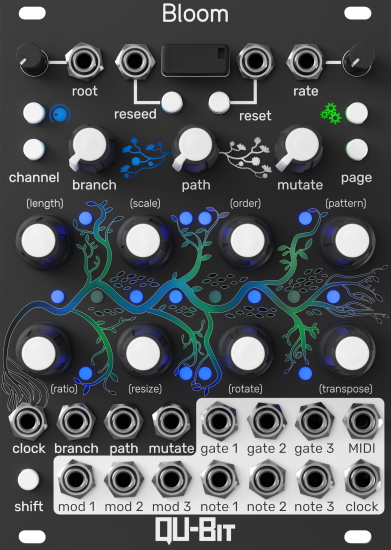Qu-Bit Electronix Bloom v2

Q-Bit Electronix, known as a California-based modular synthesis brand behind the likes of Data Bender, Nebulae, Stardust, and other premier Eurorack modules, announces the availability of the Daisy platform-based Bloom v2 - readily reimagining its mainstay sequencer as a multi-channel fractal formulation offering an abundance of additional features and configurability compared to its predecessor in ways that its creators collectively could not have hitherto imagined, yet perfectly aligns with an already established ethos of turning a knob and creating musical magic - as of June 18…
As a three-channel, 64-step CV and gate sequencer at its roots, Bloom v2 provides all the bread and butter controls considered necessary for creating a catchy, melodic sequence. Saying that, though, a quick push through the ‘leaves’ - like a tree, the enhanced Eurorack module in question features up to 128 different paths from the eight-step ‘trunk’ sequence’s seven ‘branches’ (taking those eight steps up to 64) to reach those ‘leaves’ and allow everything to musically bloom - reveals just how impressive its available array of controls actually are. After all, Bloom v2 lets users dial in any and allsequence data on a per-step basis - not just the note pitch. Put it this way: while it is perfectly possible to set gate state and length, slew amount, and ratchet amount - read: real (clock-synchronised) ratcheting, no less, users can also allow Bloom v2 to generate any aspect of the sequence by pushing the new reseed button, effectively dice-rolling the sequence for a fresh new take with each push of that button.
“Bloom was really the beginning of our foray into Qu-Bit’s new design ethos, whereby the module can take the wheel and generate beautiful music, if you want it to.” So says Qu-Bit Electronix Co-Founder Andrew Ikenberry by way of an alluring opener, before going on to reveal, “There was so much we wanted to do with the first Bloom, but couldn’t due to the hardware limitations of the time; now, with the Daisy platform, flexible USB port, and bespoke sequence editor, we really feel like Bloom v2 is the de facto Qu-Bit sequencer!”
And advancements have clearly been made above and beyond Bloom. Outside of having an additional channel and double the step length for sequences, Bloom v2 can save and load sequences - and their ‘branches’ - to and from a connected USB drive. Taking things several steps further, Qu-Bit Electronix has gone so far as to integrate a web-based sequence editor on Narwhal, its settings web app, where users can edit every aspect of a sequence - even editing the branch steps, so they can access a fully-programmable 512-step sequence - as well as setting a host of preferential behaviours and settings. Since sequences can be saved as individual files, users can share their sequences with other Bloom v2 users, adding the potential for a rich community of sequence-builders.
Eagle-eyed users of Qu-Bit Electronix’s original fractal sequencer Eurorack module will, without doubt, first become aware of a change brought about by Bloom v2’s updated layout, irrespective of its impressive new features. For instance, the main sequence encoders are now in a horizontal arrangement, with an intricate arboreal pattern weaving between each step. Furthermore, front panel artwork also acts as an eye-catching reference by illuminating which ‘Tune Mode’ the step encoders are using, with five different step editing modes currently available - namely, Note Pitch (illuminated in blue), Gate Length (green), Slew Amount (orange), Ratchet Amount (purple), and Mod Output (white).
Worth noting is the fact that the three channels on Bloom v2 each sport a new output - labelled mod 1, mod 2, and mod 3, respectively - as a CV modulation-focused affair that is fully sequence-able alongside the (self-explanatory) gate 1, gate 2, and gate 3, plus note 1, note 2, and note 3 outputs of the two other channels. But better still, there are three different output modes to choose from when working with those new outputs, Shapes being the default mod output as an LFO shape-builder mode, whereby each step can output a unique LFO shape or ratcheted variant of that shape, allowing usersto build complex modulation strings that are synchronised with the ‘trunk’ sequence; Envelope mode outputs a simple AD (Attack Decay) envelope with per-step peak control; and Stepped Voltage mode outputs a fixed voltage per step between 0V and +5V, perfect for velocity or stereo pan sequencing.
But Bloom v2’s sequences are not just outputted as voltages. Thanks to the new MIDI output and included TRS-to-MIDI cable, it can drive any MIDI-equipped device with its fractal power, and, at the same time, an onboard USB port allows it to become a MIDI host. Try transposing the sequence with a chromatic keyboard or triggering full pattern swaps on the fly with a MIDI controller. Concludes Andrew Ikenberry: “Bloom v2 really opens up generative sequencing in a whole new way. Indeed, it can be random, while surprisingly intriguing and musical, and I’m excited to share this new evolution of our sequencer with the modular community.”
Clearly, then, Bloom v2 is evolutionary, hitting all the sweet spots as a creative sequencer with its immediacy and fine-tuning abilities all rolled neatly and imaginatively into an 18HP-width Eurorack module that adds a handful of requested additions as well as a few unexpected but game-changing new features. Furthermore, it is future-proofed by being based on the easily-updatable Daisy platform, so Q-Bit Electronix will continue tending their readily reimagined mainstay sequencer while watching how Bloom v2 blossoms throughout the modular community, members of which who can continually content themselves with planting the seeds of their next patch in the meantime.
Bloom v2 is available worldwide from Qu-Bit Electronix’s growing global network of distributors with a price of $499.00 USD or directly via its dedicated webpage.
 How to resolve AdBlock issue?
How to resolve AdBlock issue?